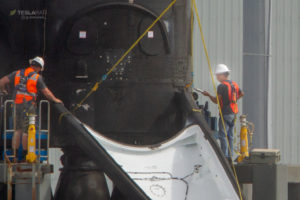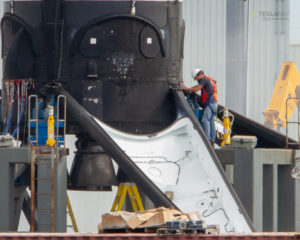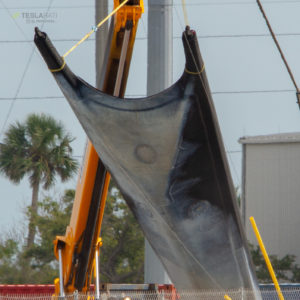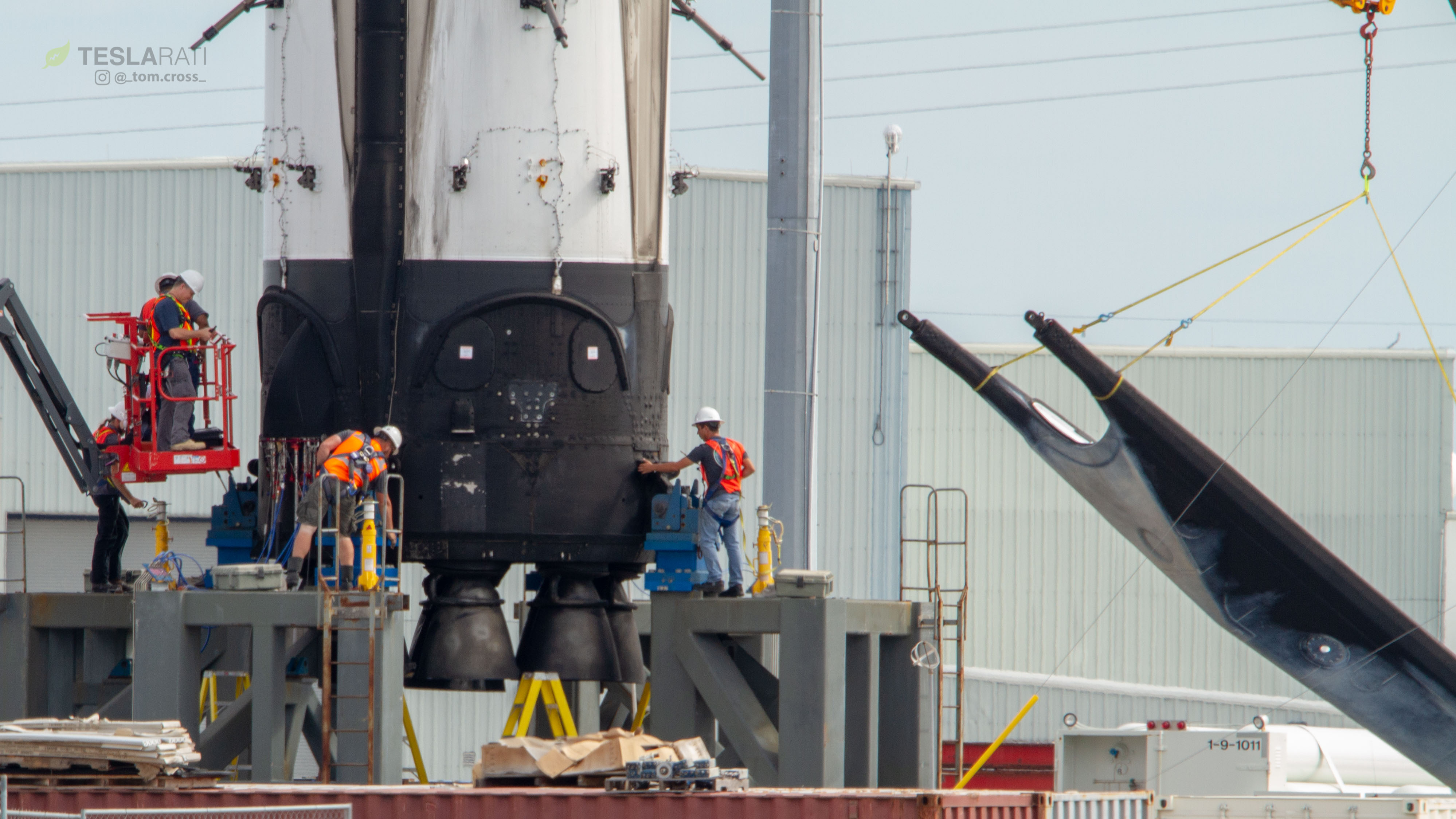

News
SpaceX team spotted removing Block 5 landing legs prior to teardown analysis
Teslarati photographer Tom Cross has captured SpaceX technicians removing the landing legs from the first Falcon 9 Block 5 booster, signaling that the end of recovery operations are near.
Of note, it appears that SpaceX chose to conduct this recovery much like previous ones by removing the rocket’s legs instead of retracting them, a feature of the Block 5 upgrade prominently noted by CEO Elon Musk and other company officials. A brief time-lapse shows workers carefully removing the legs in a well-worn ballet of heavy machinery, skirting around the massive rocket with expertise developed over the better part of two years of sea and land recoveries of Falcon 9 and Falcon Heavy boosters.
There are a number of possible reasons for SpaceX choosing to remove B1046’s landing legs the ‘old-fashioned’ way, most relating to the fact that this particular booster is a critical pathfinder for the entire future of Falcon 9 Block 5. Musk described this attitude in a lengthy and detailed prelaunch briefing:
We are going to be very rigorous in taking this rocket apart and confirming our design assumptions to be confident that it is indeed able to be reused without being taken apart. Ironically, we need to take it apart to confirm that it does not need to be taken apart.
Both COO Shotwell and Musk have briefly discussed the new functionality of the upgraded legs in the past few weeks, indicating that they are capable of being rapidly and repeatedly stowed without being removed from the rocket, whereas all past booster reuse has required the slow removable and equally slow reattachment of landing legs, assuming Block 3 and 4 boosters even reuse their same landing legs. At a minimum, Musk’s above comment already makes it clear that SpaceX has no plans to reuse this booster immediately, instead conducting an extremely thorough teardown analysis to verify that wear and tear from high-speed atmospheric reentry is within an acceptable range.
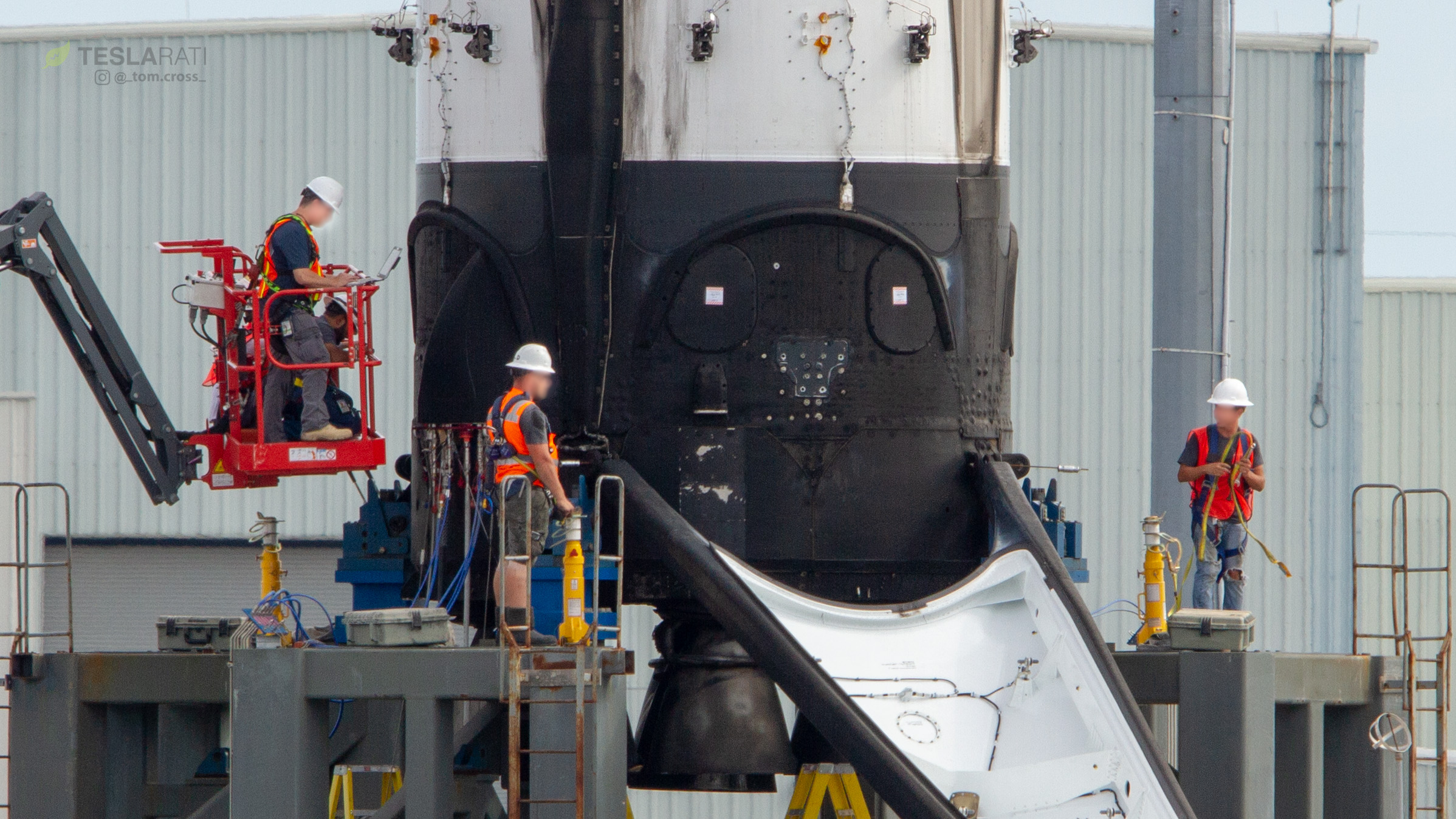
SpaceX technicians busy themselves removing Falcon 9 Block 5’s massive recovery hardware. (Tom Cross)
Equally plausible, choosing to remove B1046’s landing legs instead of testing the new retraction mechanisms may better preserve the leg hardware in its post-landing state, providing engineers and technicians cleaner and more representative data. One final obvious possibility is that the process of flight-testing new Block 5 leg hardware caused damage or led to some off-nominal telemetry and other visible faults, thus preventing them from retracting.
Because the next Block 5 booster (B1047) is likely nearing its own debut after a thorough round of testing in Texas, captured by an aerial photographer, SpaceX may be pushing hard to complete its post-landing analysis of B1046 as quickly as possible to make way for the imminent launches of several new boosters. If the company hopes to maintain its impressive 2018 flight rate of one launch every two weeks throughout the rest of the year, they will need to refly Block 5 boosters at least 10 times – the last flight-proven commercial Block 4 launch (CRS-15) is currently scheduled for early July, leaving roughly half of all 2018’s upcoming launches manifested on Block 5 Falcon 9/Heavy rockets. Falcon Heavy’s second launch has in fact been pushed back by several months per The Planetary Society, indicating that the construction of the first Block 5 center booster has taken a back seat to the more pressing concerns of Falcon 9 Block 5 boosters, upper stages, and fairings needed to avoid additional customer launch delays.

B1046’s final landing leg is removed and carried off with a forklift, presumably for teardown analysis at a SpaceX facility. (Tom Cross)
Regardless, the first successful and nearly-complete recovery of a Falcon 9 Block 5 booster marks a huge milestone for SpaceX. So long as the imminent teardown analysis does not reveal anything especially unexpected, the rocket company is quickly closing in on true rapid reuse with Octagrabber/Roomba’s steady routinization of robotic rocket saving, yet another intact fairing half recovery, and the good condition of B1046 after a relatively hot reentry and landing.
- Just boopin’ an orbital-class rocket with a huge metal component, NBD. (Tom Cross)
- (Tom Cross)
- A toasty Block 5 landing leg shows off a new patina for SpaceX’s upgraded thermal protection material.
- (Tom Cross)
Follow us for live updates, behind-the-scenes sneak peeks, and a sea of beautiful photos from our East and West coast photographers.
Teslarati – Instagram – Twitter
Tom Cross – Twitter
Pauline Acalin – Twitter
Eric Ralph – Twitter
News
Tesla begins Robotaxi certification push in Arizona: report
Tesla seems serious about expanding its Robotaxi service to several states in the coming months.

Tesla has initiated discussions with Arizona transportation regulators to certify its driverless Robotaxi service in the state, as per a recent report from Bloomberg News. The move follows Tesla’s launch of its Robotaxi pilot program in Austin, Texas, as well as CEO Elon Musk’s recent comments about the service’s expansion in the Bay Area.
The Arizona Department of Transportation confirmed to Bloomberg that Tesla has reached out to begin the certification process for autonomous ride-sharing operations in the state. While details remain limited, the outreach suggests that Tesla is serious about expanding its driverless Robotaxi service to several territories in the coming months.
The Arizona development comes as Tesla prepares to expand its service area in Austin this weekend, as per CEO Elon Musk in a post on X. Musk also stated that Tesla is targeting the San Francisco Bay Area as its next major market, with a potential launch “in a month or two,” pending regulatory approvals.
Tesla first launched its autonomous ride-hailing program on June 22 in Austin with a small fleet of Model Y vehicles, accompanied by a Tesla employee in the passenger seat to monitor safety. While still classified as a test, Musk has said the program will expand to about 1,000 vehicles in the coming months. Tesla will later upgrade its Robotaxi fleet with the Cyercab, a two-seater that is designed without a steering wheel.
Sightings of Cybercab castings around the Giga Texas complex suggests that Tesla may be ramping the initial trial production of the self-driving two-seater. Tesla, for its part, has noted in the past that volume production of the Cybercab is expected to start sometime next year.
In California, Tesla has already applied for a transportation charter-party carrier permit from the state’s Public Utilities Commission. The company is reportedly taking a phased approach to operating in California, with the Robotaxi service starting with pre-arranged rides for employees in vehicles with safety drivers.
News
Tesla sets November 6 date for 2025 Annual Shareholder Meeting
The automaker announced the date on Thursday in a Form 8-K.

Tesla has scheduled its 2025 annual shareholder meeting for November 6, addressing investor concerns that the company was nearing a legal deadline to hold the event.
The automaker announced the date on Thursday in a Form 8-K submitted to the United States Securities and Exchange Commission (SEC). The company also listed a new proposal submission deadline of July 31 for items to be included in the proxy statement.
Tesla’s announcement followed calls from a group of 27 shareholders, including the leaders of large public pension funds, which urged Tesla’s board to formally set the meeting date, as noted in a report from The Wall Street Journal.
The group noted that under Texas law, where Tesla is now incorporated, companies must hold annual meetings within 13 months of the last one if requested by shareholders. Tesla’s previous annual shareholder meeting was held on June 13, 2024, which placed the July 13 deadline in focus.
Tesla originally stated in its 2024 annual report that it would file its proxy statement by the end of April. However, an amended filing on April 30 indicated that the Board of Directors had not yet finalized a meeting date, at least at the time.
The April filing also confirmed that Tesla’s board had formed a special committee to evaluate certain matters related to CEO Elon Musk’s compensation plan. Musk’s CEO performance award remains at the center of a lengthy legal dispute in Delaware, Tesla’s former state of incorporation.
Due to the aftermath of Musk’s legal dispute about his compensation plan in Delaware, he has not been paid for his work at Tesla for several years. Musk, for his part, has noted that he is more concerned about his voting stake in Tesla than his actual salary.
At last year’s annual meeting, TSLA shareholders voted to reapprove Elon Musk’s compensation plan and ratified Tesla’s decision to relocate its legal domicile from Delaware to Texas.
Elon Musk
Grok coming to Tesla vehicles next week “at the latest:” Elon Musk
Grok’s rollout to Tesla vehicles is expected to begin next week at the latest.

Elon Musk announced on Thursday that Grok, the large language model developed by his startup xAI, will soon be available in Tesla vehicles. Grok’s rollout to Tesla vehicles is expected to begin next week at the latest, further deepening the ties between the two Elon Musk-led companies.
Tesla–xAI synergy
Musk confirmed the news on X shortly after livestreaming the release of Grok 4, xAI’s latest large language model. “Grok is coming to Tesla vehicles very soon. Next week at the latest,” Musk wrote in a post on social media platform X.
During the livestream, Musk and several members of the xAI team highlighted several upgrades to Grok 4’s voice capabilities and performance metrics, positioning the LLM as competitive with top-tier models from OpenAI and Google.
The in-vehicle integration of Grok marks a new chapter in Tesla’s AI development. While Tesla has long relied on in-house systems for autonomous driving and energy optimization, Grok’s integration would introduce conversational AI directly into its vehicles’ user experience. This integration could potentially improve customer interaction inside Tesla vehicles.
xAI and Tesla’s collaborative footprint
Grok’s upcoming rollout to Tesla vehicles adds to a growing business relationship between Tesla and xAI. Earlier this year, Tesla disclosed that it generated $198.3 million in revenue from commercial, consulting, and support agreements with xAI, as noted in a report from Bloomberg News. A large portion of that amount, however, came from the sale of Megapack energy storage systems to the artificial intelligence startup.
In July 2023, Musk polled X users about whether Tesla should invest $5 billion in xAI. While no formal investment has been made so far, 68% of poll participants voted yes, and Musk has since stated that the idea would be discussed with Tesla’s board.
-

 Elon Musk1 week ago
Elon Musk1 week agoTesla investors will be shocked by Jim Cramer’s latest assessment
-

 Elon Musk19 hours ago
Elon Musk19 hours agoxAI launches Grok 4 with new $300/month SuperGrok Heavy subscription
-

 Elon Musk3 days ago
Elon Musk3 days agoElon Musk confirms Grok 4 launch on July 9 with livestream event
-

 News7 days ago
News7 days agoTesla Model 3 ranks as the safest new car in Europe for 2025, per Euro NCAP tests
-

 Elon Musk2 weeks ago
Elon Musk2 weeks agoA Tesla just delivered itself to a customer autonomously, Elon Musk confirms
-

 Elon Musk1 week ago
Elon Musk1 week agoxAI’s Memphis data center receives air permit despite community criticism
-

 Elon Musk2 weeks ago
Elon Musk2 weeks agoTesla’s Omead Afshar, known as Elon Musk’s right-hand man, leaves company: reports
-

 News2 weeks ago
News2 weeks agoXiaomi CEO congratulates Tesla on first FSD delivery: “We have to continue learning!”

